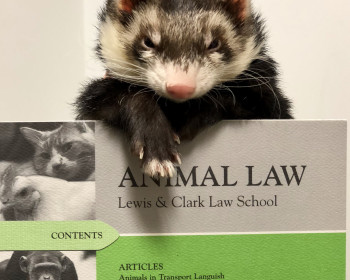Volume 25 Issue 3
ARTICLES
ANIMAL LAW: THE NEXT GENERATION
Joyce Tischler & Pamela Frasch
The animal law movement and animal law education in law schools has been growing over the years. In this Article, prominent figures in the animal law world discuss this growth as well as changes that are expected within the next generation of animal law practice. The authors suggest important goals necessary to strengthen the movement in order to allow law students to access the resources needed to be powerful animal advocates for years to come.
FIVE MORE YEARS FOR THE ANIMALS
David S. Favre
For Animal Law’s twenty-fifth anniversary edition, David S. Favre is back with an update on the state of animal law in the United States. This piece covers the new, the changeless, the good, and the bad of the animal legal landscape in the past five years since Animal Law last asked Favre to write a review of animal law. An overview of new case law is discussed, as is a summary of newly passed state laws, mostly related to companion animals. Additionally, developments in the ever-expanding field of animal legal education are examined. This Article discusses changes in a variety of animal-related areas-from criminal law, to animals in entertainment, to animal rights-in the last five years.
THE STRUGGLE FOR THE LEGAL RIGHTS OF NONHUMAN ANIMALS BEGINS: THE EXPERIENCE OF THE NONHUMAN RIGHTS PROJECT IN NEW YORK AND CONNECTICUT
Steven M. Wise
Twenty-five years ago, in the first issue of Animal Law, the author offered an account of why legal rights do not need to be restricted to human beings. Here the author expands upon that account to provide a review of the ongoing struggle of the Non-Human Rights Project (NhRP) to obtain legal rights for nonhuman animals. The author outlines habeas corpus cases the NhRp has brought on behalf of chimpanzees and elephants in New York and Connecticut and provides a view of the New York and Connecticut Pet Trust Statutes, which grant domestic or pet animals the right to be named a beneficiary of a trust, thereby implicitly creating their legal personhood. This Article further argues that legal personhood does not necessarily attach to humans alone and illuminates the varieties of judicial responses it has encountered in its effort to persuade courts to assign legal personhood to nonhuman animals.
A QUARTER OF A CENTURY OF ANIMAL LAW: OUR ROOTS, OUR GROWTH, AND OUR STRETCH TOWARD THE SUN
Nancy Perry
This Article explores the author’s experience as one of the early student pioneers of the animal law program at Lewis & Clark Law. The author discusses her work on the Oregon Cougar and Bear Initiative as an introduction to the power of the ballot initiative process. The Article then recounts the progress that has been made by animal advocates via federal and state legislation and ballot measures, as well as the setbacks driven by industry interest. It concludes with a discussion of the need for a good defense as industry interests attempt to roll back the progress made by animal advocates over the years.
PERSONAL REFLECTIONS ON BEING A POSTCOLONIAL FEMINIST ANIMAL LAW PROFESSOR
Maneesha Deckha
The author reflects on her experiences in the field of animal law. A recurring theme throughout the Article is the author’s struggle to see herself as being part of the animal law at all. This is because mainstream animal law writing has tended to take a liberal legal approach, while the author has focused her work around concepts of intersectionality, feminist, and postcolonial theory in a field she has self-described as “Philosophy, Critical Theory, and Animal Ethics.” Consistent with her intersectional approach, the author highlights how her experience being Canadian, being female, and being ‘radicalized’ have all intersected to shape her experiences and perceptions working in animal law. Her conclusion is that, fundamentally, the animal law movement is a women’s movement, given it is women who predominate in the membership and, as such, the success and future of animal law “depend on whether women’s voices on behalf of animals will be listened to and respected.”
RUMINATIONS ON TWENTY-FIVE YEARS OF ANIMAL LAW
Joan E. Schaffner
In this Article, the author tracks the ‘progress’ of the animal law movement over the past twenty-five years, focusing on the perennial ambiguity in the property status of animals and the kinds of harm to animals the law is, and is not, willing to condone, and the power of the media to shed light on these harms. The author also explains how her own work, concentrating on the problem of legal valuation of companion animals for damages claims in the debate around ‘no kill’ shelters and trap, neuter, release (TNR) programs, and the ‘problem’ of feral cats. Overall, the author concludes that her experience in animal law has been a positive one, reflecting fondly on finding her home among a community of like-minded, passionate individuals who care about sentient beings.
FARMED ANIMALS: THE PAST IS PROLOGUE, THE FUTURE IS (ALMOST) HERE…
Mariann Sullivan
The author describes her journey to animal law and the contributions she had made to the field, particularly in respect of ballot initiatives that have been used successfully to make specific improvements to the welfare of farmed animals. She provides an overview of the Florida ballot initiative prohibiting the confinement of pigs during pregnancy and the California ballot initiatives setting a minimum cage size for laying hens and more, highlighting how the idea for each initiative was born, and the drafting and implementation challenges encountered along the way. The author also focuses on other legal and non-legal strategies that are being deployed in the ever-growing animal law movement, such as undercover investigations and the author’s own popular podcast, the Hen House and the Animal Law Podcast. Sadly, despite this work, farmed animals continue to suffer in large numbers. While the author considers that there is a greater public awareness of farmed animal welfare issues, partly as a result of successful ballot initiatives, the future of animal law remains to be seen.
REVIEWS
2018 STATE LEGISLATIVE REVIEW
Emma Therrien
There were several important changes to animal protection in the United States in 2018. California became the first state to ban cosmetic testing on animals and also made improvements for a handful of species in factory farming. Prop 12 was passed, increasing minimum sizes standards for these species but the most drastic change was the banning of eggs produced by egg-laying hens housed in cages-effectively prohibiting the use of cages for these birds in the state and the sale of eggs from produces that use cages in production out of state. Florida and New Jersey made influential advancements for animals by banning greyhound racing and prohibiting traveling circuses from using wild animals in shows, respectively. Although some states introduced legislation that can potentially harm animals, like Iowa’s conventional egg law, there was a general wave of strengthening animal protection among the states that many are hopeful will carry over to 2019.
2018 FEDERAL LEGISLATIVE REVIEW
Anna Fugate
2018 was a slow year for federal animal law legislation. Congress only signed the Endangered Salmon Predation Prevention Act into law, and that law permits the killing of sea lions to protect endangered salmon and steelhead populations. While Congress considered other animal legislation, none of this proposed legislation made it out of Congressional Committees and Subcommittees.
2018 FOREIGN AND INTERNATIONAL LEGISLATIVE REVIEW
Caitlin Skurky
This Review examines foreign and international legislation relating to animals proposed or passed in 2018 and early 2019. The Review specifically examines legislation in Vietnam, Switzerland, Spain, Canada, Luxembourg, the U.K., Ukraine, and Portugal, with a specific focus on legislation that seeks to increase animal welfare, reduce consumption of cruel animal products, or end violent animal practices.
More Animal Law Review Stories
Animal Law Review is located in Wood Hall on the Law Campus.
MSC: 51
voice 503-768-6798
Editor in Chief
Melissa Baines Keipper
eic-animallaw@lclark.edu
Managing Editor
Emily Boden Torres
me-animallaw@lclark.edu
Executive Editors
Betsy Randolph
Justin Gabel
ee-animallaw@lclark.edu
Animal Law Review
Lewis & Clark Law School
10101 S. Terwilliger Boulevard MSC 51
Portland OR 97219


